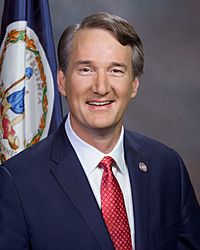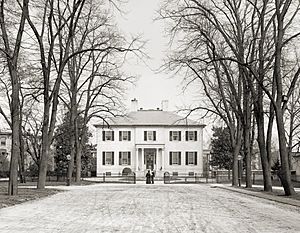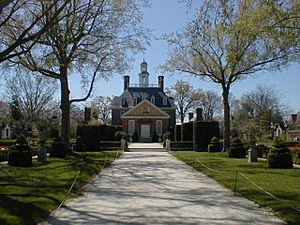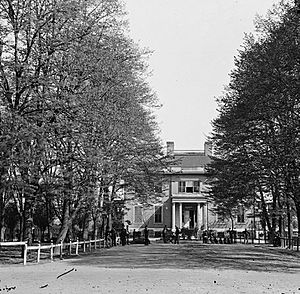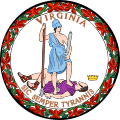Governor of Virginia facts for kids
Quick facts for kids Governor of theCommonwealth of Virginia |
|
|---|---|

|
|
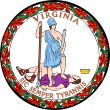
|
|
| Government of Virginia | |
| Style |
|
| Residence | Virginia Executive Mansion |
| Term length | Four years, not eligible for immediate re-election |
| Formation | July 5, 1776 |
| First holder | Patrick Henry |
| Succession | Line of succession |
| Deputy | Lieutenant Governor of Virginia |
| Salary | $175,000 (2013) |
The Governor of the Commonwealth of Virginia is the leader of the government in Virginia. Think of the governor as the chief executive officer for the state. They are in charge of the executive branch and also lead the Virginia National Guard and Virginia Defense Force.
Did you know that three people who signed the Declaration of Independence later became governors of Virginia? Also, three governors of Virginia went on to become president of the United States: Thomas Jefferson, James Monroe, and John Tyler.
The person serving as governor right now is Glenn Youngkin. He is a member of the Republican Party and started his term on January 15, 2022.
Contents
What is the Oath of Office?
On the day they become governor, the person who was elected takes a special promise called an oath. They promise to support the Constitution of the United States and the Virginia Constitution. They also promise to do their job as Governor of Virginia fairly and to the best of their ability.
What Does it Take to Be Governor?
To become Governor of Virginia, a person must meet a few requirements:
- They must be a citizen of the United States.
- They need to be at least thirty years old.
- They must have lived in Virginia and been a registered voter for at least five years before the election.
Unlike governors in many other states, Virginia's governors cannot serve two terms in a row. This rule has been in place since 1830. However, a former governor can run for the job again in a future election. Only two governors since 1830, William Smith and Mills Godwin, have been elected for a second term later on.
To get their name on the ballot for governor, candidates need to collect 10,000 signatures. These signatures must come from registered voters across Virginia, with at least 400 from each of the state's 11 congressional districts.
What are the Governor's Duties?
The governor is the main leader of Virginia's government. Here are some of their key duties:
- They report on the state of Virginia to the Virginia General Assembly (which includes the House of Delegates and the Senate) at the start of each regular meeting.
- They can call the legislature together for special meetings if two-thirds of each house asks for it.
- The governor makes sure that Virginia's laws are followed. They do this by either signing bills into law, letting them become law without a signature, or saying no to them (vetoing them).
- They are also responsible for the safety of the state, acting as the leader of the Virginia Militia.
What Powers Does the Governor Have?
The governor has several important powers:
- They can suggest new laws and call for special meetings of the legislature when needed.
- The governor has the power to veto laws. This means that all bills must go to the governor before they can become law. The governor can sign the bill, let it become law after seven days without signing, or veto it. If a bill is vetoed, it goes back to the legislature, which can still make it a law if two-thirds of both houses vote for it.
- The governor can also use a "line-item veto." This allows them to send parts of a bill back to the legislature with changes. The legislature must then approve these changes or override the veto with a two-thirds vote.
- The governor is the commander-in-chief of Virginia's military forces.
- They can also talk with other states and countries.
- The governor can fill empty positions in the government, unless the legislature is supposed to appoint someone.
- They have the power to reduce fines or sentences and to give pardons. A pardon means someone is forgiven for a crime. The governor can also give back voting rights to people who lost them.
How Does Succession Work?
If the governor cannot do their job, someone else steps in. This is called the line of succession.
| Order | Office | Current Person |
|---|---|---|
| 0 | Governor of Virginia | Glenn Youngkin (R) |
| 1 | Lieutenant Governor | Winsome Sears (R) |
| 2 | Attorney General | Jason Miyares (R) |
| 3 | Speaker of the House of Delegates | Don Scott (D) |
| 4 | The House of Delegates meets to choose someone for the empty spot. | |
A Brief History of Virginia's Governors
Early Days: Colony and Province
The role of governor in Virginia goes all the way back to 1607. That's when the first permanent English settlement in America was founded at Jamestown. At first, a council in London ran the colony. The person leading the council in Virginia was like the first governor. Edward Maria Wingfield was the first to actually govern Virginia from within the colony.
Later, in 1624, King James I of England took control from the Virginia Company. Virginia became a "crown colony," meaning the king appointed the governors. Often, the appointed governor stayed in England, and a deputy or lieutenant governor did the actual work in Virginia.
Virginia as a Commonwealth
Virginia became an independent state, or "Commonwealth," during the American Revolutionary War (1775–1783). Patrick Henry was its first governor. From the Revolution until 1851, the governor was chosen by the Virginia General Assembly (the state legislature). After 1851, people started voting directly for the governor.
During the American Civil War (1861–1865), there were different governors for the parts of Virginia that stayed with the Union. After the war, the U.S. government appointed governors for a while. In 1874, Virginia got back its right to choose its own governor.
Interestingly, since 1977, the governor elected in Virginia has usually been from the opposite political party of the U.S. president elected the year before. This has happened even when Virginia voted for that president! The only time this didn't happen was in 2013, when Democrat Terry McAuliffe was elected after President Barack Obama was re-elected in 2012.
Tim Kaine became governor on January 14, 2006. His inauguration was held in Williamsburg, making him the first governor since Thomas Jefferson in 1779 to be sworn in there. The current governor, Glenn Youngkin, took office on January 15, 2022.
How to Address the Governor
The Governor of Virginia is usually called "The Honorable." Sometimes, in very formal situations, they might be called "Excellency."
Images for kids
-
Glenn Youngkin, the current Governor of Virginia.
See also
 In Spanish: Gobernador de Virginia para niños
In Spanish: Gobernador de Virginia para niños


